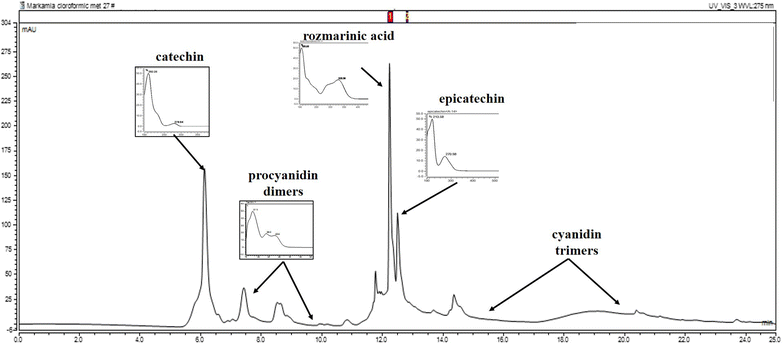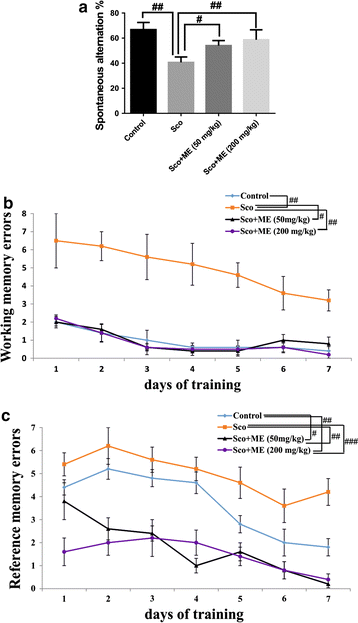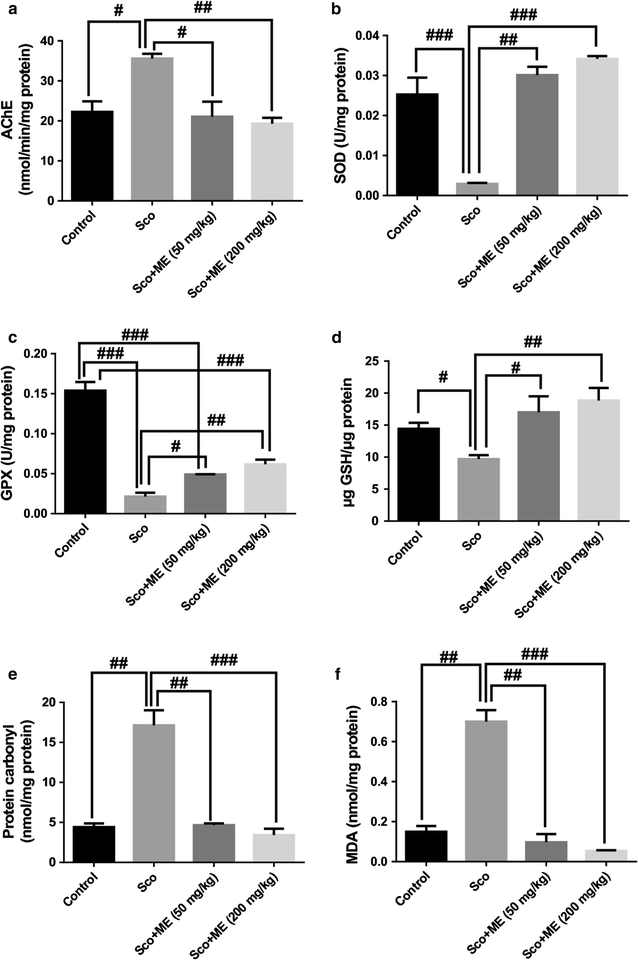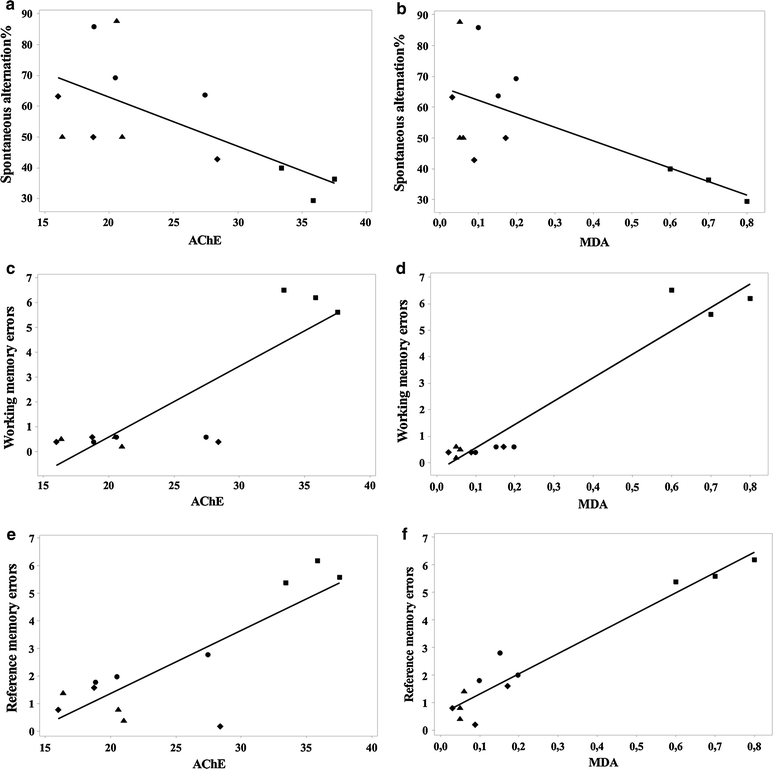Cognitive-enhancing and antioxidant activities of the aqueous extract from Markhamia tomentosa (Benth.) K. Schum. stem bark in a rat model of scopolamine
- PMID: 28351401
- PMCID: PMC5371259
- DOI: 10.1186/s12993-017-0123-6
Cognitive-enhancing and antioxidant activities of the aqueous extract from Markhamia tomentosa (Benth.) K. Schum. stem bark in a rat model of scopolamine
Abstract
Background: Plants of the genus Markhamia have been traditionally used by different tribes in various parts of West African countries, including Cameroun. Markhamia tomentosa (Benth.) K. Schum. (Bignoniaceae) is used as an antimalarial, anti-inflammatory, analgesic, antioxidant and anti-Alzheimer agent. The current study was undertaken in order to investigate its anti-amnesic and antioxidant potential on scopolamine-induced cognitive impairment and to determine its possible mechanism of action.
Methods: Rats were pretreated with the aqueous extract (50 and 200 mg/kg, p.o.), for 10 days, and received a single injection of scopolamine (0.7 mg/kg, i.p.) before training in Y-maze and radial arm-maze tests. The biochemical parameters in the rat hippocampus were also assessed to explore oxidative status. Statistical analyses were performed using two-way ANOVA followed by Tukey's post hoc test. F values for which p < 0.05 were regarded as statistically significant.
Results: In the scopolamine-treated rats, the aqueous extract improved memory in behavioral tests and decreased the oxidative stress in the rat hippocampus. Also, the aqueous extract exhibited anti-acetylcholinesterase activity.
Conclusions: These results suggest that the aqueous extract ameliorates scopolamine-induced spatial memory impairment by attenuation of the oxidative stress in the rat hippocampus.
Keywords: Acetylcholinesterase; Alzheimer’s disease; Markhamia tomentosa stem bark extract; Oxidative stress; Scopolamine; Spatial memory.
Figures





Similar articles
-
Effects of the Methanolic Extract of Vitellaria paradoxa Stem Bark Against Scopolamine-Induced Cognitive Dysfunction and Oxidative Stress in the Rat Hippocampus.Cell Mol Neurobiol. 2016 Oct;36(7):1139-49. doi: 10.1007/s10571-015-0310-7. Epub 2015 Nov 30. Cell Mol Neurobiol. 2016. PMID: 26620052 Free PMC article.
-
Ameliorative effects of Matricaria chamomilla L. hydroalcoholic extract on scopolamine-induced memory impairment in rats: A behavioral and molecular study.Phytomedicine. 2018 Aug 1;47:113-120. doi: 10.1016/j.phymed.2018.04.049. Epub 2018 May 7. Phytomedicine. 2018. PMID: 30166095
-
Marrubium vulgare Extract Improves Spatial Working Memory and Oxidative Stress Damage in Scopolamine-Treated Rats.J Alzheimers Dis. 2024;99(s1):S157-S169. doi: 10.3233/JAD-231011. J Alzheimers Dis. 2024. PMID: 38489175
-
Anti-inflammatory activity of Markhamia tomentosa (Benth.) K. Schum. Ex Engl. ethanolic leaf extract.J Ethnopharmacol. 2013 Aug 26;149(1):191-4. doi: 10.1016/j.jep.2013.06.020. Epub 2013 Jun 20. J Ethnopharmacol. 2013. PMID: 23792584
-
Main Plant Extracts' Active Properties Effective on Scopolamine-Induced Memory Loss.Am J Alzheimers Dis Other Demen. 2017 Nov;32(7):418-428. doi: 10.1177/1533317517715906. Epub 2017 Jun 23. Am J Alzheimers Dis Other Demen. 2017. PMID: 28643520 Free PMC article. Review.
Cited by
-
Anxiolytic, Promnesic, Anti-Acetylcholinesterase and Antioxidant Effects of Cotinine and 6-Hydroxy-L-Nicotine in Scopolamine-Induced Zebrafish (Danio rerio) Model of Alzheimer's Disease.Antioxidants (Basel). 2021 Feb 1;10(2):212. doi: 10.3390/antiox10020212. Antioxidants (Basel). 2021. PMID: 33535660 Free PMC article.
-
Exploring Medicinal Herbs' Therapeutic Potential and Molecular Docking Analysis for Compounds as Potential Inhibitors of Human Acetylcholinesterase in Alzheimer's Disease Treatment.Medicina (Kaunas). 2023 Oct 12;59(10):1812. doi: 10.3390/medicina59101812. Medicina (Kaunas). 2023. PMID: 37893530 Free PMC article.
-
In Vivo Cognitive-Enhancing, Ex Vivo Malondialdehyde-Lowering Activities and Phytochemical Profiles of Aqueous and Methanolic Stem Bark Extracts of Piliostigma thonningii (Schum.).Int J Alzheimers Dis. 2020 Mar 24;2020:1367075. doi: 10.1155/2020/1367075. eCollection 2020. Int J Alzheimers Dis. 2020. PMID: 32308992 Free PMC article.
-
Effects of Piper nigrum fruit and Cinnamum zeylanicum bark alcoholic extracts, alone and in combination, on scopolamine-induced memory impairment in mice.Res Pharm Sci. 2021 Aug 19;16(5):474-481. doi: 10.4103/1735-5362.323914. eCollection 2021 Oct. Res Pharm Sci. 2021. PMID: 34522195 Free PMC article.
-
Exercise Rehabilitation and/or Astragaloside Attenuate Amyloid-beta Pathology by Reversing BDNF/TrkB Signaling Deficits and Mitochondrial Dysfunction.Mol Neurobiol. 2022 May;59(5):3091-3109. doi: 10.1007/s12035-022-02728-3. Epub 2022 Mar 9. Mol Neurobiol. 2022. PMID: 35262870
References
-
- Inestrosa NC, Alvarez A, Pérez CA, Moreno RD, Vicente M, Linker C, Casanueva OI, Soto C, Garrido J. Acetylcholinesterase accelerates assembly of amyloid-β-peptides into Alzheimer’s fibrils: possible role of the peripheral site of the enzyme. Neuron. 1996;16(4):881–891. doi: 10.1016/S0896-6273(00)80108-7. - DOI - PubMed
MeSH terms
Substances
LinkOut - more resources
Full Text Sources
Other Literature Sources

